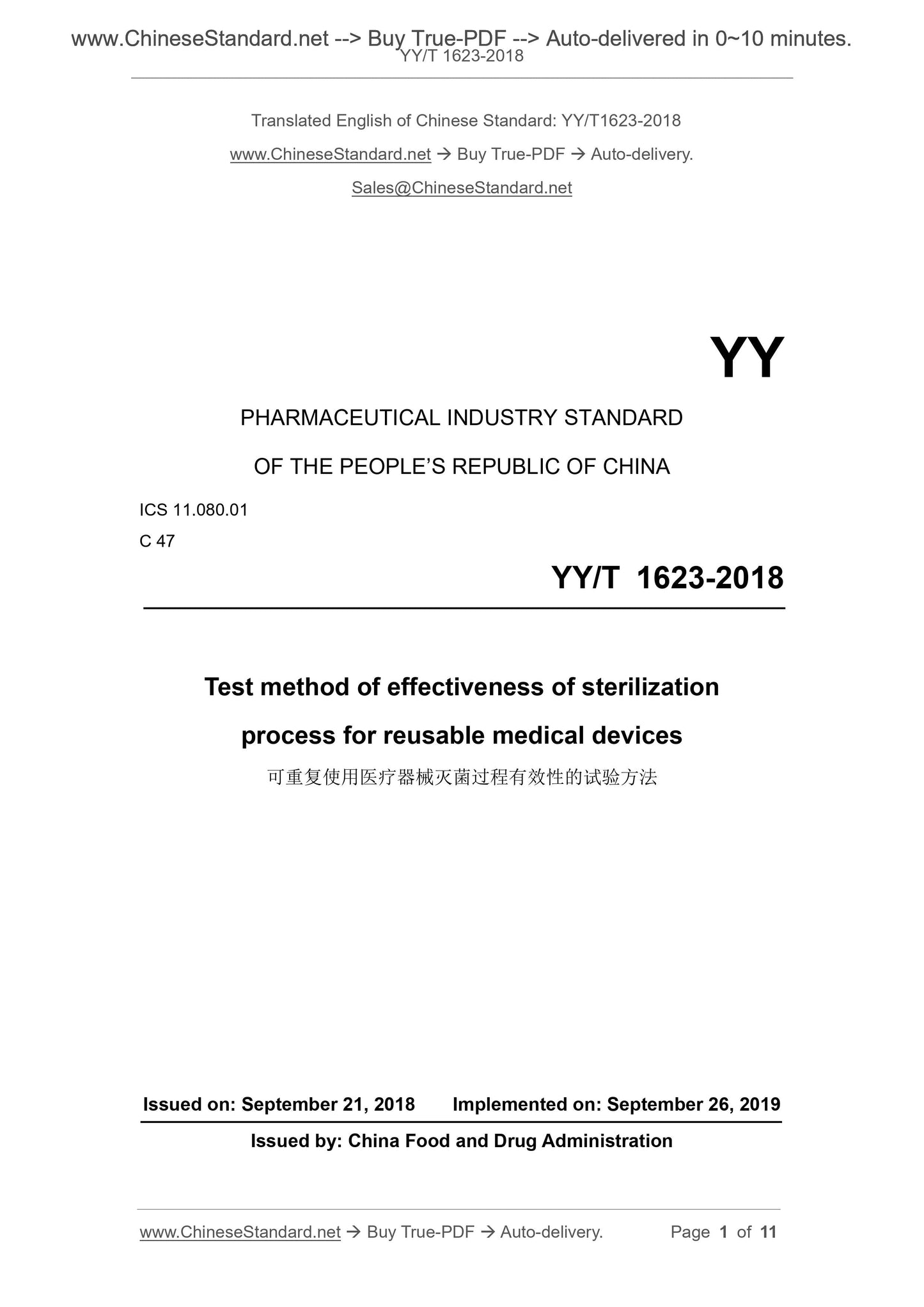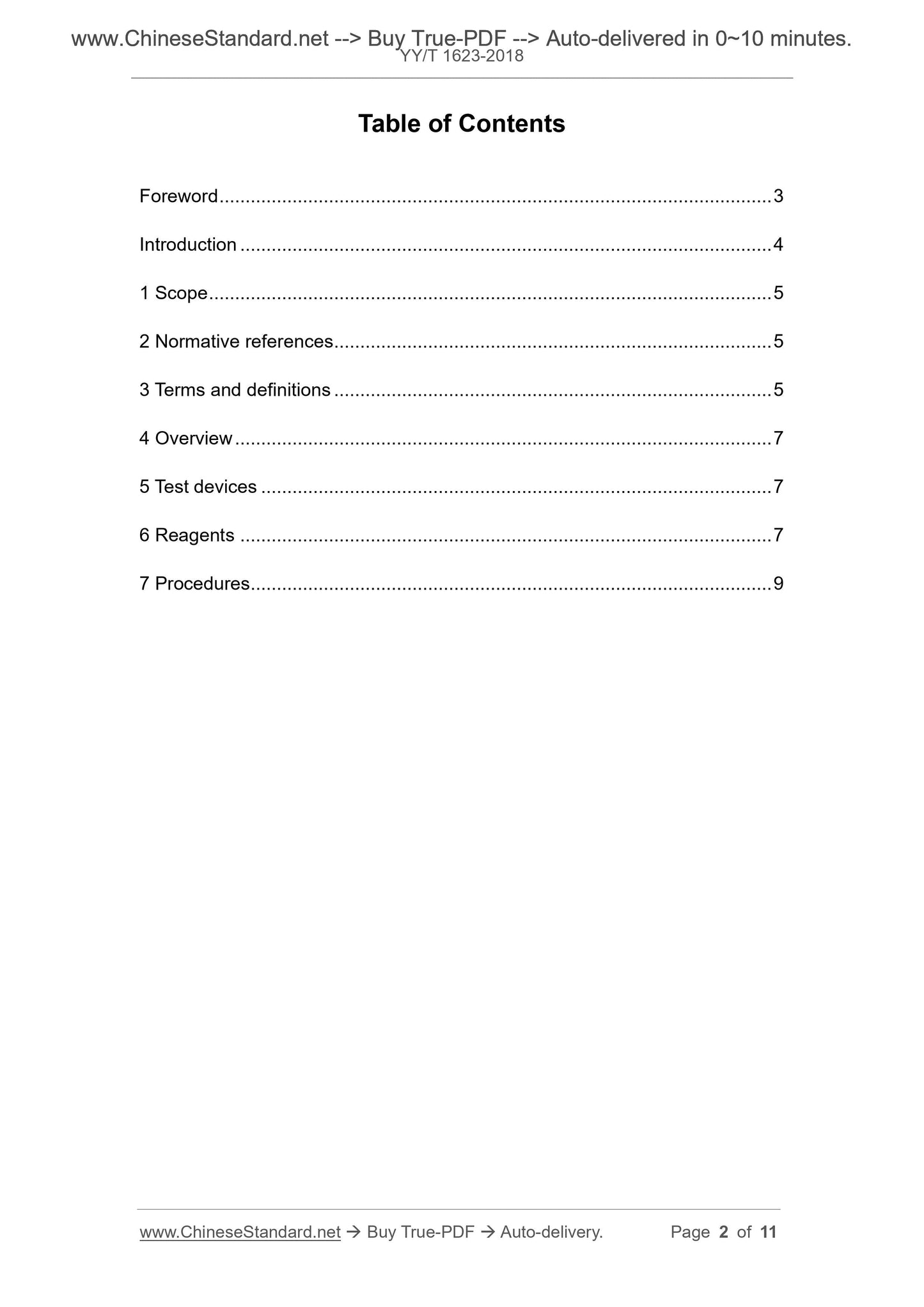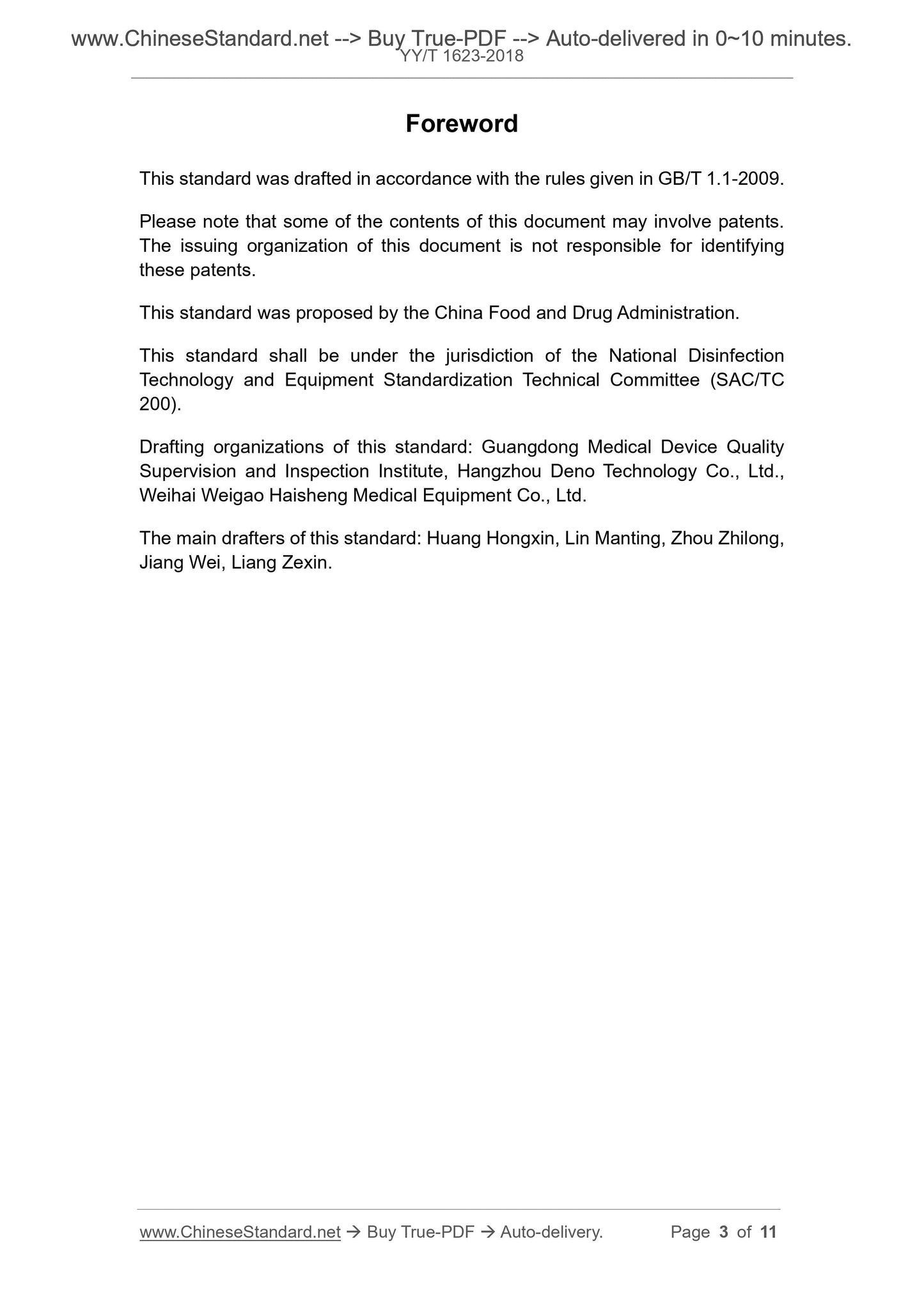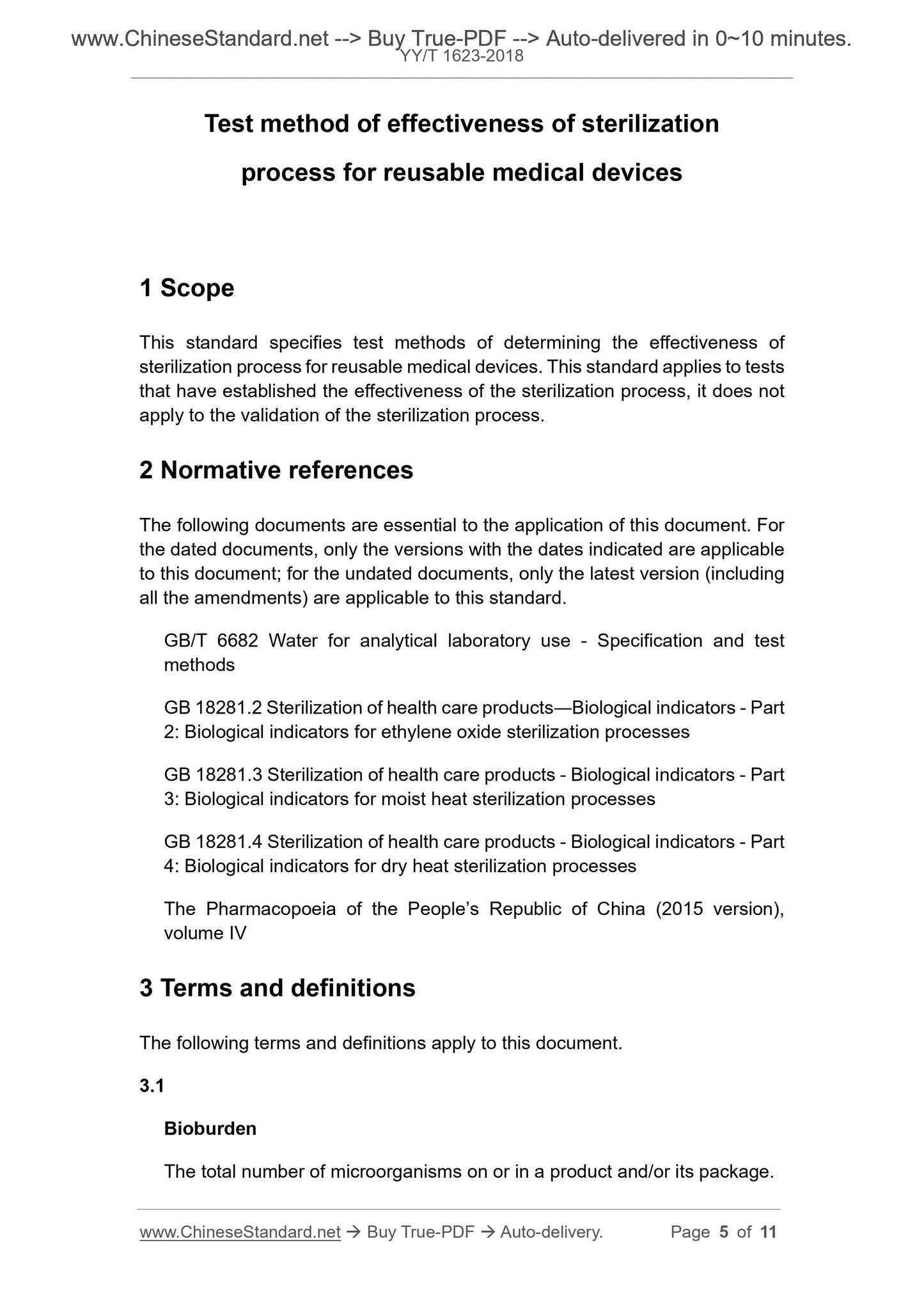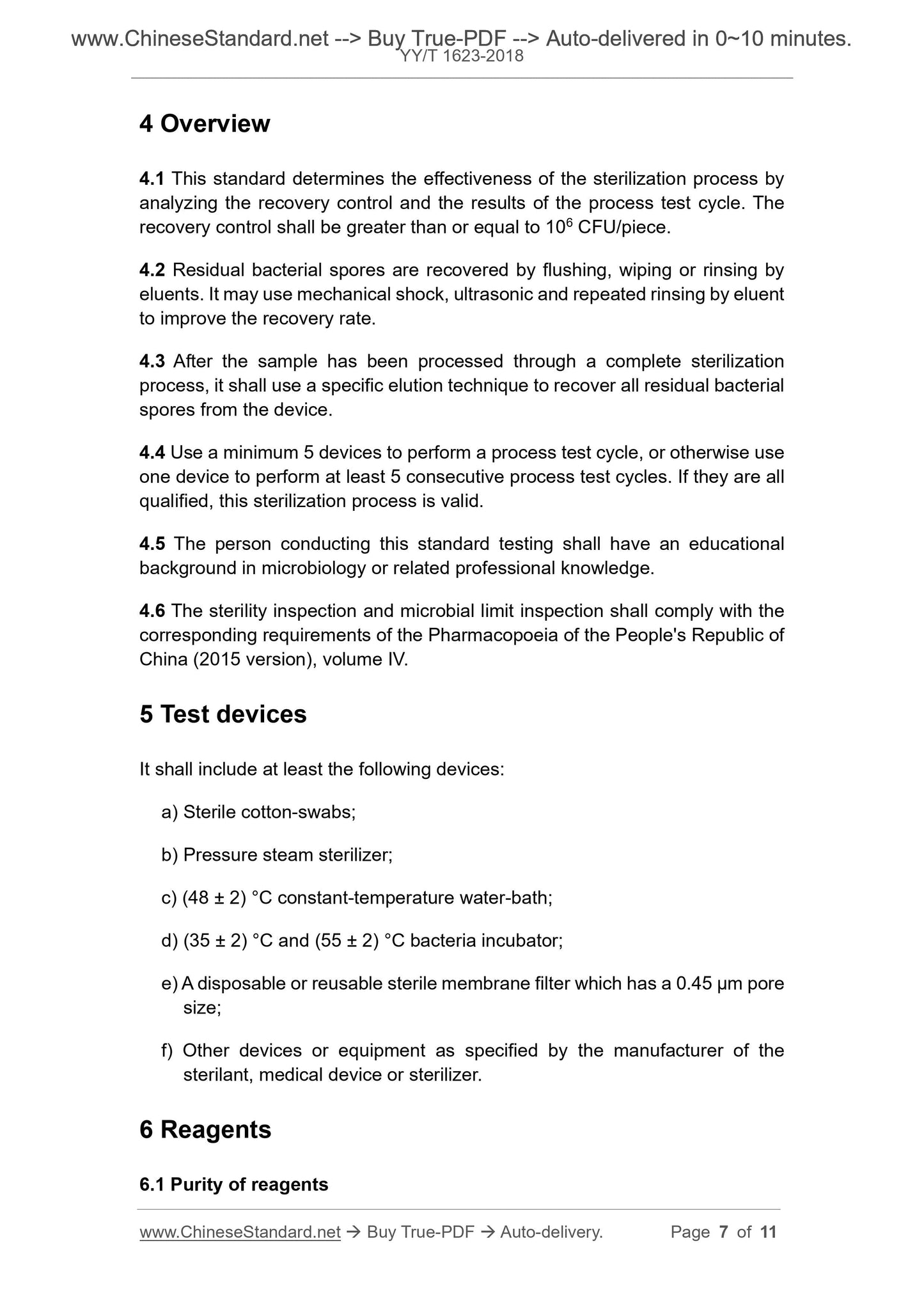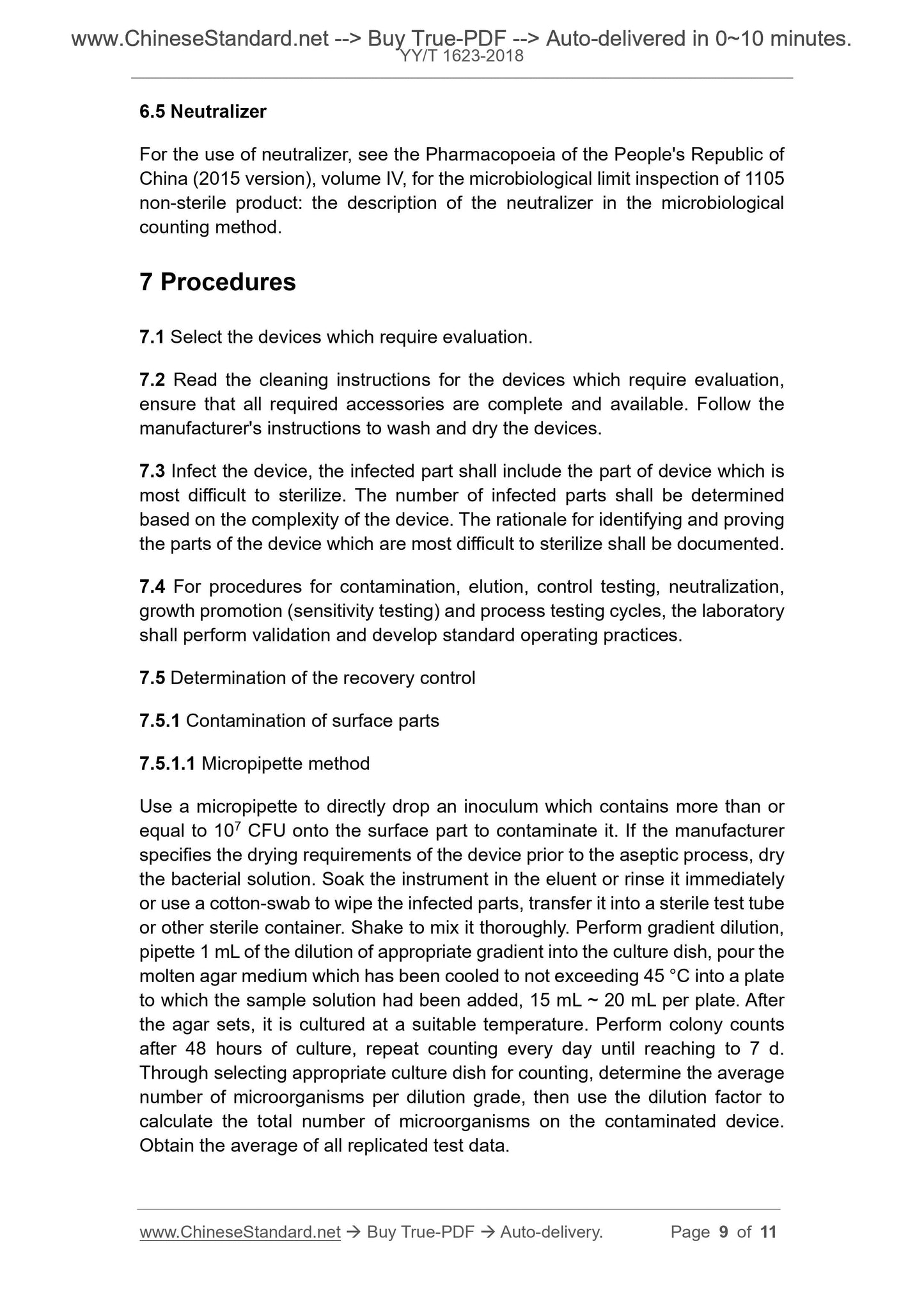1
/
의
6
PayPal, credit cards. Download editable-PDF & invoice in 1 second!
YY/T 1623-2018 English PDF (YYT1623-2018)
YY/T 1623-2018 English PDF (YYT1623-2018)
정가
$175.00 USD
정가
할인가
$175.00 USD
단가
/
단위
배송료는 결제 시 계산됩니다.
픽업 사용 가능 여부를 로드할 수 없습니다.
Delivery: 3 seconds. Download true-PDF + Invoice.
Get QUOTATION in 1-minute: Click YY/T 1623-2018
Historical versions: YY/T 1623-2018
Preview True-PDF (Reload/Scroll if blank)
YY/T 1623-2018: Test method of effectiveness of sterilization processes for reusable medical devices
YY/T 1623-2018
YY
PHARMACEUTICAL INDUSTRY STANDARD
OF THE PEOPLE’S REPUBLIC OF CHINA
ICS 11.080.01
C 47
Test method of effectiveness of sterilization
process for reusable medical devices
ISSUED ON. SEPTEMBER 21, 2018
IMPLEMENTED ON. SEPTEMBER 26, 2019
Issued by. China Food and Drug Administration
Table of Contents
Foreword ... 3
Introduction ... 4
1 Scope ... 5
2 Normative references ... 5
3 Terms and definitions ... 5
4 Overview ... 7
5 Test devices ... 7
6 Reagents ... 7
7 Procedures ... 9
Foreword
This standard was drafted in accordance with the rules given in GB/T 1.1-2009.
Please note that some of the contents of this document may involve patents.
The issuing organization of this document is not responsible for identifying
these patents.
This standard was proposed by the China Food and Drug Administration.
This standard shall be under the jurisdiction of the National Disinfection
Technology and Equipment Standardization Technical Committee (SAC/TC
200).
Drafting organizations of this standard. Guangdong Medical Device Quality
Supervision and Inspection Institute, Hangzhou Deno Technology Co., Ltd.,
Weihai Weigao Haisheng Medical Equipment Co., Ltd.
The main drafters of this standard. Huang Hongxin, Lin Manting, Zhou Zhilong,
Jiang Wei, Liang Zexin.
Test method of effectiveness of sterilization
process for reusable medical devices
1 Scope
This standard specifies test methods of determining the effectiveness of
sterilization process for reusable medical devices. This standard applies to tests
that have established the effectiveness of the sterilization process, it does not
apply to the validation of the sterilization process.
2 Normative references
The following documents are essential to the application of this document. For
the dated documents, only the versions with the dates indicated are applicable
to this document; for the undated documents, only the latest version (including
all the amendments) are applicable to this standard.
GB/T 6682 Water for analytical laboratory use - Specification and test
methods
GB 18281.2 Sterilization of health care products―Biological indicators - Part
2. Biological indicators for ethylene oxide sterilization processes
GB 18281.3 Sterilization of health care products - Biological indicators - Part
3. Biological indicators for moist heat sterilization processes
GB 18281.4 Sterilization of health care products - Biological indicators - Part
4. Biological indicators for dry heat sterilization processes
The Pharmacopoeia of the People’s Republic of China (2015 version),
volume IV
3 Terms and definitions
The following terms and definitions apply to this document.
3.1
Bioburden
The total number of microorganisms on or in a product and/or its package.
4 Overview
4.1 This standard determines the effectiveness of the sterilization process by
analyzing the recovery control and the results of the process test cycle. The
recovery control shall be greater than or equal to 106 CFU/piece.
4.2 Residual bacterial spores are recovered by flushing, wiping or rinsing by
eluents. It may use mechanical shock, ultrasonic and repeated rinsing by eluent
to improve the recovery rate.
4.3 After the sample has been processed through a complete sterilization
process, it shall use a specific elution technique to recover all residual bacterial
spores from the device.
4.4 Use a minimum 5 devices to perform a process test cycle, or otherwise use
one device to perform at least 5 consecutive process test cycles. If they are all
qualified, this sterilization process is valid.
4.5 The person conducting this standard testing shall have an educational
background in microbiology or related professional knowledge.
4.6 The sterility inspection and microbial limit inspection shall comply with the
corresponding requirements of the Pharmacopoeia of the People's Republic of
China (2015 version), volume IV.
5 Test devices
It shall include at least the following devices.
a) Sterile cotton-swabs;
b) Pressure steam sterilizer;
c) (48 ± 2) °C constant-temperature water-bath;
d) (35 ± 2) °C and (55 ± 2) °C bacteria incubator;
e) A disposable or reusable sterile membrane filter which has a 0.45 μm pore
size;
f) Other devices or equipment as specified by the manufacturer of the
sterilant, medical device or sterilizer.
6 Reagents
6.1 Purity of reagents
6.5 Neutralizer
For the use of neutralizer, see the Pharmacopoeia of the People's Republic of
China (2015 version), volume IV, for the microbiological limit inspection of 1105
non-sterile product. the description of the neutralizer in the microbiological
counting method.
7 Procedures
7.1 Select the devices which require evaluation.
7.2 Read the cleaning instructions for the devices which require evaluation,
ensure that all required accessories are complete and available. Follow the
manufacturer's instructions to wash and dry the devices.
7.3 Infect the device, the infected part shall include the part of device which is
most difficult to sterilize. The number of infected parts shall be determined
based on the complexity of the device. The rationale for identifying and proving
the parts of the device which are most difficult to sterilize shall be documented.
7.4 For procedures for contamination, elution, control testing, neutralization,
growth promotion (sensitivity testing) and process testing cycles, the laboratory
shall perform validation and develop standard operating practices.
7.5 Determination of the recovery control
7.5.1 Contamination of surface parts
7.5.1.1 Micropipette method
Use a micropipette to directly drop an inoculum which contains more than or
equal to 107 CFU onto the surface part to contaminate it. If the manufacturer
specifies the drying requirements of the device prior to the aseptic process, dry
the bacterial solution. Soak the instrument in the eluent or rinse it immediately
or use a cotton-swab to wipe the infected parts, transfer it into a sterile test tube
or other sterile container. Shake to mix it thoroughly. Perform gradient dilution,
pipette 1 mL of the dilution of appropriate gradient into the culture dish, pour the
molten agar medium which has been cooled to not exceeding 45 °C into a plate
to which the sample solution had been added, 15 mL ~ 20 mL per plate. After
the agar sets, it is cultured at a suitable temperature. Perform colony counts
after 48 hours of culture, repeat counting every day until reaching to 7 d.
Through selecting appropriate culture dish for counting, determine the average
number of microorganisms per dilution grade, then use the dilution factor to
calculate the total number of microorganisms on the contaminated device.
Obtain the average of all replicated test data.
Get QUOTATION in 1-minute: Click YY/T 1623-2018
Historical versions: YY/T 1623-2018
Preview True-PDF (Reload/Scroll if blank)
YY/T 1623-2018: Test method of effectiveness of sterilization processes for reusable medical devices
YY/T 1623-2018
YY
PHARMACEUTICAL INDUSTRY STANDARD
OF THE PEOPLE’S REPUBLIC OF CHINA
ICS 11.080.01
C 47
Test method of effectiveness of sterilization
process for reusable medical devices
ISSUED ON. SEPTEMBER 21, 2018
IMPLEMENTED ON. SEPTEMBER 26, 2019
Issued by. China Food and Drug Administration
Table of Contents
Foreword ... 3
Introduction ... 4
1 Scope ... 5
2 Normative references ... 5
3 Terms and definitions ... 5
4 Overview ... 7
5 Test devices ... 7
6 Reagents ... 7
7 Procedures ... 9
Foreword
This standard was drafted in accordance with the rules given in GB/T 1.1-2009.
Please note that some of the contents of this document may involve patents.
The issuing organization of this document is not responsible for identifying
these patents.
This standard was proposed by the China Food and Drug Administration.
This standard shall be under the jurisdiction of the National Disinfection
Technology and Equipment Standardization Technical Committee (SAC/TC
200).
Drafting organizations of this standard. Guangdong Medical Device Quality
Supervision and Inspection Institute, Hangzhou Deno Technology Co., Ltd.,
Weihai Weigao Haisheng Medical Equipment Co., Ltd.
The main drafters of this standard. Huang Hongxin, Lin Manting, Zhou Zhilong,
Jiang Wei, Liang Zexin.
Test method of effectiveness of sterilization
process for reusable medical devices
1 Scope
This standard specifies test methods of determining the effectiveness of
sterilization process for reusable medical devices. This standard applies to tests
that have established the effectiveness of the sterilization process, it does not
apply to the validation of the sterilization process.
2 Normative references
The following documents are essential to the application of this document. For
the dated documents, only the versions with the dates indicated are applicable
to this document; for the undated documents, only the latest version (including
all the amendments) are applicable to this standard.
GB/T 6682 Water for analytical laboratory use - Specification and test
methods
GB 18281.2 Sterilization of health care products―Biological indicators - Part
2. Biological indicators for ethylene oxide sterilization processes
GB 18281.3 Sterilization of health care products - Biological indicators - Part
3. Biological indicators for moist heat sterilization processes
GB 18281.4 Sterilization of health care products - Biological indicators - Part
4. Biological indicators for dry heat sterilization processes
The Pharmacopoeia of the People’s Republic of China (2015 version),
volume IV
3 Terms and definitions
The following terms and definitions apply to this document.
3.1
Bioburden
The total number of microorganisms on or in a product and/or its package.
4 Overview
4.1 This standard determines the effectiveness of the sterilization process by
analyzing the recovery control and the results of the process test cycle. The
recovery control shall be greater than or equal to 106 CFU/piece.
4.2 Residual bacterial spores are recovered by flushing, wiping or rinsing by
eluents. It may use mechanical shock, ultrasonic and repeated rinsing by eluent
to improve the recovery rate.
4.3 After the sample has been processed through a complete sterilization
process, it shall use a specific elution technique to recover all residual bacterial
spores from the device.
4.4 Use a minimum 5 devices to perform a process test cycle, or otherwise use
one device to perform at least 5 consecutive process test cycles. If they are all
qualified, this sterilization process is valid.
4.5 The person conducting this standard testing shall have an educational
background in microbiology or related professional knowledge.
4.6 The sterility inspection and microbial limit inspection shall comply with the
corresponding requirements of the Pharmacopoeia of the People's Republic of
China (2015 version), volume IV.
5 Test devices
It shall include at least the following devices.
a) Sterile cotton-swabs;
b) Pressure steam sterilizer;
c) (48 ± 2) °C constant-temperature water-bath;
d) (35 ± 2) °C and (55 ± 2) °C bacteria incubator;
e) A disposable or reusable sterile membrane filter which has a 0.45 μm pore
size;
f) Other devices or equipment as specified by the manufacturer of the
sterilant, medical device or sterilizer.
6 Reagents
6.1 Purity of reagents
6.5 Neutralizer
For the use of neutralizer, see the Pharmacopoeia of the People's Republic of
China (2015 version), volume IV, for the microbiological limit inspection of 1105
non-sterile product. the description of the neutralizer in the microbiological
counting method.
7 Procedures
7.1 Select the devices which require evaluation.
7.2 Read the cleaning instructions for the devices which require evaluation,
ensure that all required accessories are complete and available. Follow the
manufacturer's instructions to wash and dry the devices.
7.3 Infect the device, the infected part shall include the part of device which is
most difficult to sterilize. The number of infected parts shall be determined
based on the complexity of the device. The rationale for identifying and proving
the parts of the device which are most difficult to sterilize shall be documented.
7.4 For procedures for contamination, elution, control testing, neutralization,
growth promotion (sensitivity testing) and process testing cycles, the laboratory
shall perform validation and develop standard operating practices.
7.5 Determination of the recovery control
7.5.1 Contamination of surface parts
7.5.1.1 Micropipette method
Use a micropipette to directly drop an inoculum which contains more than or
equal to 107 CFU onto the surface part to contaminate it. If the manufacturer
specifies the drying requirements of the device prior to the aseptic process, dry
the bacterial solution. Soak the instrument in the eluent or rinse it immediately
or use a cotton-swab to wipe the infected parts, transfer it into a sterile test tube
or other sterile container. Shake to mix it thoroughly. Perform gradient dilution,
pipette 1 mL of the dilution of appropriate gradient into the culture dish, pour the
molten agar medium which has been cooled to not exceeding 45 °C into a plate
to which the sample solution had been added, 15 mL ~ 20 mL per plate. After
the agar sets, it is cultured at a suitable temperature. Perform colony counts
after 48 hours of culture, repeat counting every day until reaching to 7 d.
Through selecting appropriate culture dish for counting, determine the average
number of microorganisms per dilution grade, then use the dilution factor to
calculate the total number of microorganisms on the contaminated device.
Obtain the average of all replicated test data.
Share
